Deep in the Mekong Delta, two Frenchmen who cofounded Vietnam’s first artisan chocolate maker bury their heads in a sack of cacao beans before resurfacing, murmuring appreciatively.
The sweet-toothed entrepreneurs — who quit their day jobs to set up award-winning chocolate company Marou — buy three out of four of 64-year-old farmer Vo Thanh Phuoc’s sacks of dried, fermented cacao, paying a premium on the market price for the better-than-average beans.
“When we started, the farmers thought we were crazy,” Marou cofounder Vincent Mourou told reporters as he nibbled on a cacao nib.
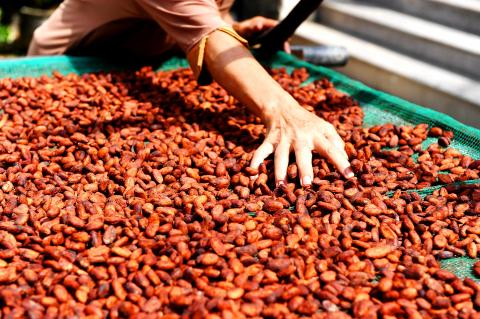
Photo: AFP
Every sack of beans is individually checked, since the smell, color, texture and taste give a good indication of the chocolate to come.
“Now, they try the beans too,” Mourou said.
Cacao was most likely first introduced in Vietnam by French colonialists in the late 19th century, but never took off as a cash crop.
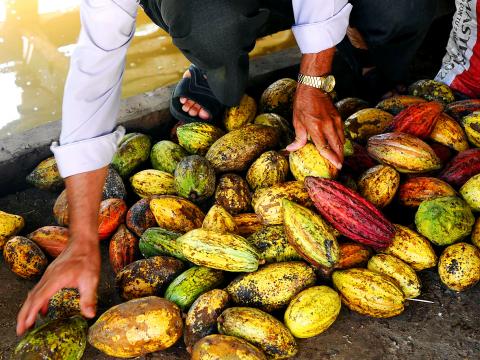
Photo: AFP
As demand for high-quality chocolate rises globally — particularly in emerging markets — while supply from traditional producers like Ivory Coast falls due to ageing tree stock and other problems, the industry is eyeing communist Vietnam as a new supplier.
Cacao prices hit two-and-a-half-year highs late last month amid concerns over inventory and some industry figures are warning of a possible deficit of 1 million tonnes by 2020.
The chocolate industry is “desperate to diversify” its supply of beans, which would lessen the risk of supply crunches owing to disease or political unrest, World Bank lead economist in Hanoi Chris Jackson said.
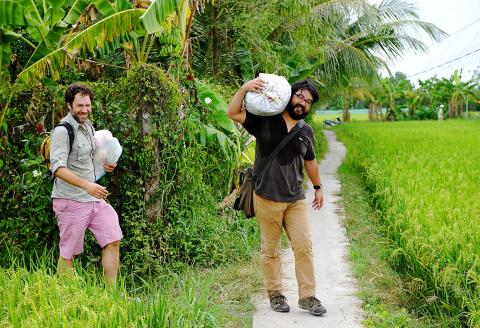
Photo: AFP
Current cacao production in the Southeast Asian country is just 5,000 tonnes per year, compared with the approximately 1.4 million tonnes exported by the Ivory Coast, according to the International Cocoa Organization.
This figure needs to grow to give the cacao industry a chance in Vietnam, said Gricha Safarian, managing director of Puratos Grand-Place, a Belgian joint venture that produces the majority of chocolate used locally in Vietnam — by hotels, bakeries and ice cream companies — and exports high-quality chocolate and cacao beans.
“Vietnam has a place to take as a medium-size producer of quality beans,” said Safarian, who has worked in Vietnam’s nascent cacao industry for two decades.
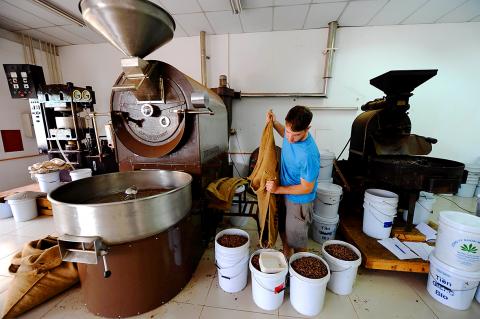
Photo: AFP
“Year by year, the market is going to be more rewarding for quality beans because of this coming shortage” as demand for quality chocolate rises, especially in Asia, he added.
Vietnam’s chocolate has “a different flavor profile — the Vietnamese beans are rather different from the African bean,” which makes it stand out in the market, he said.
“The cacao sector in Vietnam is really at a crossroads: it could go for quality or quantity,” said Vien Kim Cuong, program manager for Swiss NGO Helvetas, which works with cacao farmers on certification.
The country is well-known for cheap agricultural exports like coffee — it provides 50 percent of the world’s low-end Robusta beans — and catfish so cheap it is repeatedly hit by US anti-dumping measures.
Marou and Puratos Grand-Place want the government to take a different, more upmarket route with the cacao sector: They are trying to add value locally and build a reputation for Vietnamese luxury chocolate.
“We transform an agricultural product — the cacao bean plus sugar — into a high-quality chocolate that we position as a premium product on the export market,” said Safarian, whose Made in Vietnam chocolate is found in top restaurants from Paris to Tokyo.
For Marou cofounder Samuel Maruta, setting up an artisan chocolate company in a country not known for cacao, chocolate or even high-quality export goods was a risk.
Howebver, the pair have successfully positioned their Vietnamese single-origin chocolate as part of a growing bean-to-bar revolution, a rebellion against homogeneity in an industry dominated by major players like the US’ Kraft Food Groups Inc and Italy’s Ferrero SpA.
Mass-produced chocolate can be “incredibly soulless,” said Maruta — a world apart from the rich, fruity, spicy notes found in a bar of the company’s 78 percent dark chocolate.
From their Ho Chi Minh City-based factory, the French entrepreneurs are now exporting close to 2 tonnes of chocolate every month to about 15 countries.
The pair want Vietnam “to push quality cacao, so that Vietnamese cacao is known for quality and not quantity,” Maruta said.
Officials at state department VinaCacao said they aimed to increase cacao production by about five-fold by 2020, but declined to provide further details.
Major buyers, including industry leader MARS Inc, are eager for Vietnam to grow more higher-quality “certified” beans. MARS has pledged to use only certified beans by 2020.
“Vietnam will play a role in providing certified quality beans to MARS,” which is working locally to train farmers and research new cacao strains, MARS Vietnam cocoa development manager Dinh Hai Lam told reporters.
The only other country to go into cacao production in recent years is Indonesia, which focuses only on producing a high volume of low-end, unfermented beans.
Cacao can be a good earner for farmers, but only if they can get a premium for their beans and the premium is based on the quality, Safarian said.
Ironically, the people who are the most difficult to convince about the quality of chocolate from Vietnam are Vietnamese.
“The Vietnamese consumer does not trust the product of his own country yet,” Safarian said, referring to local consumers’ preference for imported goods because they are perceived as being of a higher quality.
“This will change. You cannot approach the chocolate market in Vietnam as you approach it in France or Belgium,” he said, adding that while there is not likely to be much of a market for praline, the emerging middle class is already developing a taste for chocolate.
“Being in this business for 30 years, I have still never met anyone who doesn’t like chocolate at first bite,” Safarian said.
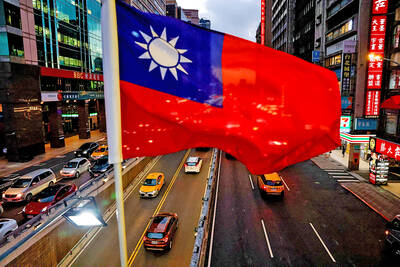
AI BOOST: Although Taiwan’s reliance on Chinese rare earth elements is limited, it could face indirect impacts from supply issues and price volatility, an economist said DBS Bank Ltd (星展銀行) has sharply raised its forecast for Taiwan’s economic growth this year to 5.6 percent, citing stronger-than-expected exports and investment linked to artificial intelligence (AI), as it said that the current momentum could peak soon. The acceleration of the global AI race has fueled a surge in Taiwan’s AI-related capital spending and exports of information and communications technology (ICT) products, which have been key drivers of growth this year. “We have revised our GDP forecast for Taiwan upward to 5.6 percent from 4 percent, an upgrade that mainly reflects stronger-than-expected AI-related exports and investment in the third
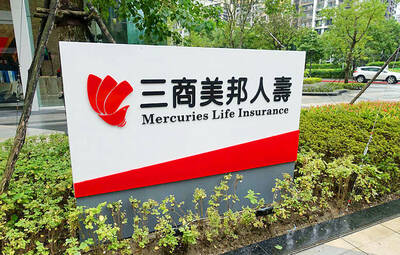
Mercuries Life Insurance Co (三商美邦人壽) shares surged to a seven-month high this week after local media reported that E.Sun Financial Holding Co (玉山金控) had outbid CTBC Financial Holding Co (中信金控) in the financially strained insurer’s ongoing sale process. Shares of the mid-sized life insurer climbed 5.8 percent this week to NT$6.72, extending a nearly 18 percent rally over the past month, as investors bet on the likelihood of an impending takeover. The final round of bidding closed on Thursday, marking a critical step in the 32-year-old insurer’s search for a buyer after years of struggling to meet capital adequacy requirements. Local media reports

TECHNOLOGICAL RIVALRY: The artificial intelligence chip competition among multiple players would likely intensify over the next two years, a Quanta official said Quanta Computer Inc (廣達), which makes servers and laptops on a contract basis, yesterday said its shipments of artificial intelligence (AI) servers powered by Nvidia Corp’s GB300 chips have increased steadily since last month, should surpass those of the GB200 models this quarter. The production of GB300 servers has gone much more smoothly than that of the GB200, with shipments projected to increase sharply next month, Quanta executive vice president Mike Yang (楊麒令) said on the sidelines of a technology forum in Taipei. While orders for GB200 servers gradually decrease, the production transition between the two server models has been
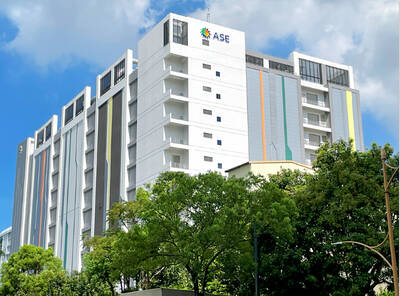
ASE Technology Holding Co (日月光投控), the world’s largest integrated circuit (IC) packaging and testing supplier, yesterday announced a strategic collaboration with Analog Devices Inc (ADI), coupled with the signing of a binding memorandum of understanding. Under the agreement, ASE intends to purchase 100 percent shares of Analog Devices Sdn Bhd and acquire its manufacturing facility in Penang, Malaysia, a press release showed. The ADI Penang facility is located in the prime industrial hub of Bayan Lepas, with an area of over 680,000 square feet, it said. In addition, the two sides intend to enter into a long-term supply agreement for ASE to